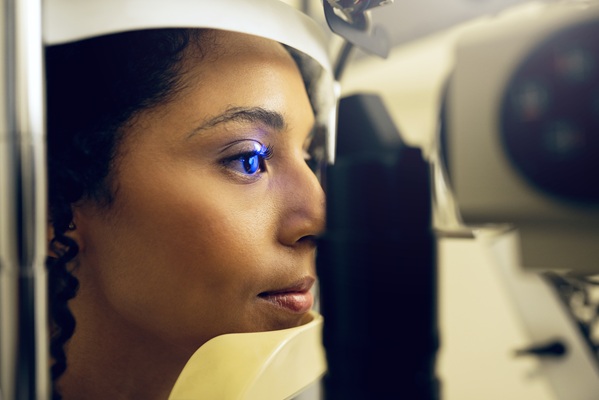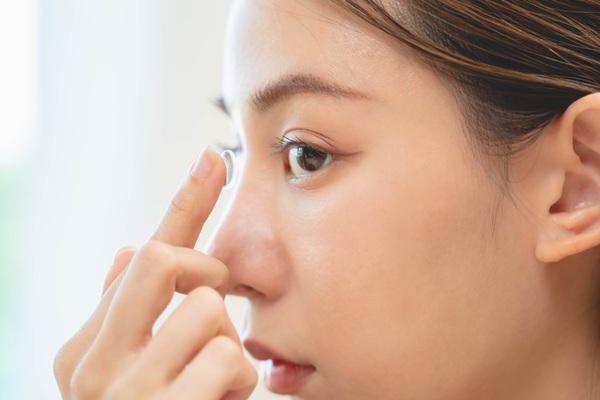FAQs About Eyeglasses and Contact Lenses

It is vital for those who wear eyeglasses and contact lenses to know how to properly care for their eyewear. The following are some of the most frequently asked questions that patients have regarding glasses and contacts.
Is there a difference between eyeglass and contact lens prescriptions?
Eyeglass and contact lens prescriptions are vastly different, and one cannot be substituted for the other. Patients will need two different exams if they want a prescription for both contact lenses and eyeglasses. The difference in the exam is due to the position of the corrective lenses; contact data is measured for lenses that are on the surface of the eye while eyeglasses are measured for lenses that are 12 millimeters from the eyes.
How often are eye exams needed for eyeglasses and contacts?
Patients are advised to go for annual eye exams to check the health of the eyes and to be sure eyeglass and contact lens prescriptions are still up to date. Routine eye exams can help determine even minor changes in vision that may not be noticeable so corrections can be made to avoid eye strain. If there are any signs of vision changes, such as blurry vision and headaches, patients should make an appointment for an eye exam as soon as possible. While the examinations for contacts and eyeglasses are different, both can be scheduled during the same visit.
What are the numbers on an eyeglass prescription?
The first number is the sphere, which is indicative of the power that is needed to correct myopia (nearsightedness) or hyperopia (farsightedness). If there is a minus sign before this number, it indicates the power that is needed to correct myopia. If there is a plus sign, it indicates the power needed to correct farsightedness. The second number is the cylinder, which identifies an astigmatism. The third number is the axis, which is the direction and degree of the astigmatism.
There are usually abbreviations on the prescription as well; O.S., which stands for oculus sinister, is for the left eye, and O.D. is the abbreviation for oculus dexter, which is for the right eye.
Is it safe to sleep in contact lenses?
Sleeping in contact lenses is not recommended because the cornea receives less oxygen and lubrication while the eyes are closed. There is even less oxygen flow to the cornea when contacts are worn overnight. This allows bacteria to multiply, creating an increased risk of developing eye infections that could lead to permanent vision loss.
Wearing contact lenses while sleeping can also cause eye irritation and corneal abrasions. If patients have slept in lenses and have signs of an infection, such as red or watery eyes, discharge, or decreased vision, it is important to be seen by an optometrist as soon as possible.
Are prescriptions the same for eyeglasses and contact lenses?
The simple answer is no. In fact, eyeglasses and contact lens prescriptions are usually very different, in large part due to the differences in how both options work. Contact lenses rest directly on the surface of the eyes, whereas glasses are about 12 millimeters from your eyes.
Is it better to wear glasses or contact lenses when working on the computer?
There is no direct answer as to whether glasses or contact lenses are better for working on the computer. However, if eye concerns are caused or made worse by computer use, then it may help to have prescription glasses designed to reduce digital eye strain and fatigue. It may also help to rotate between glasses and contact lenses as well to reduce overall strain and fatigue on the eyes.
What are the cost differences between eyeglasses and contact lenses?
Contact lenses generally cost more than eyeglasses over time, although initially, eyeglasses cost more. Of course, this is because contact lenses must be replaced far more often. On average, the cost of eyeglasses is about half the cost of contact lenses annually, although this number can vary based on a variety of factors, including how well the individual cares for their glasses and/or contact lenses.
How do I determine which option is right for me?
The best way to determine whether eyeglasses or contact lenses are the better option for you is to visit with an eye doctor and discuss your goals and preferences.
Choosing an option
It is crucial to learn the answers to the most common questions about eyeglasses and contact lenses to ensure proper eye care. This will result in maintaining optimal eye health.
Request an appointment here: https://www.texasoptical.net or call Texas Optical at (214) 771-7333 for an appointment in our Dallas office.
Check out what others are saying about our services on Yelp: Read our Yelp reviews.
Recent Posts
For those living with diabetes, undergoing a diabetic eye exam is one of the most important steps in protecting their vision and overall eye health. High blood sugar levels can lead to a range of complications, including conditions that damage the eyes over time. These exams help detect these issues before they become serious, allowing…
Contact lenses provide clear vision and convenience for individuals who prefer an alternative to eyeglasses. However, proper care and maintenance are essential to prevent infections, irritation, and eye damage. Neglecting hygiene practices can lead to serious eye conditions, including corneal ulcers and keratitis. Understanding how to clean, store, and handle contact lenses ensures long-term eye…
Maintaining eye health and preventing long-term issues is the result of consistent and quality vision care. Many people focus on overall wellness but may overlook daily habits that support healthy eyesight. However, taking simple steps each day can protect vision, reduce eye strain, and prevent future complications. By making eye health a priority, it is…
Prescription contacts provide vision correction, comfort, and convenience for those who do not want to wear glasses. However, caring for and wearing contacts takes some getting used to. Learning to insert, remove, and maintain them will help ensure a comfortable and safe experience.Not all contact lenses are the same, and choosing the right pair is…


